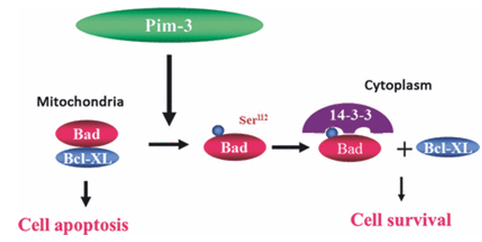
Our promise to you:
Guaranteed product quality, expert customer support.
 24x7 CUSTOMER SERVICE
24x7 CUSTOMER SERVICE
 CONTACT US TO ORDER
CONTACT US TO ORDER
Pim3 Gene Editing 
The serine/threonine kinase Pim family consists of the following three members: Pim-1, Pim-2, and Pim-3. These enzymes can widely phosphorylate a variety of specific substrates and play important regulatory roles in cell proliferation, differentiation, and apoptosis. Pim-1 and Pim-2 were proved to be oncogenes in mouse model. Pim-1 and Pim-2 increase was mainly found in hematologic malignancies and PCa. Overexpression of Pim-1 can selectively inhibit cell and tumor growth in a cell line-dependent manner. Pim-3 is expressed in many normal organs and is overexpressed particularly in tumor tissues of endoderm-derived organs such as the liver, pancreas, and colon. Li et al. suggested Pim-3 can promote growth and angiogenesis of human pancreatic cancer cells in vivo in an orthotopic nude mouse model. This gene cooperates with the proto-oncogene Myc to cause tumors; Pim-3 also has anti-apoptosis functions.
Roles of Pim3 in Cancer
Researchers observed that Pim-3 shRNA treatment decreases in vitro proliferation of various types of cancer cells by promoting apoptosis. The proapoptotic BH3-only protein Bad is the main regulator of apoptosis. By phosphorylating Bad at Ser112, Pim-1 and Pim-2 inactivate it, finally inhibiting apoptosis. Similarly, enforced expression of Pim-3 increases the number of Bad phosphorylated at Ser112, whereas Pim-3 shRNA treatment decreases Bad phosphorylation at Ser112. Therefore, it is likely that Pim-3 inhibits the apoptosis of cancer cells and eventually furthers carcinogenesis. Forced expression of Pim-3 can promote anchorage-independent growth and coexpression of a kinase-deficient Pim-3 mutant can reduce EWS/FLI-mediated NIH 3T3 tumorigenesis in immunodeficient mice. These observations suggest that Pim-3 may be involved in this carcinogenic model.
 Figure 1. Presumed mechanisms involved in Pim-3-mediated inhibition of apoptosis. (Mukaida N, et al., 2011)
Figure 1. Presumed mechanisms involved in Pim-3-mediated inhibition of apoptosis. (Mukaida N, et al., 2011)
Initially, Pim-1 and Pim-2 were associated with cell survival to suppress myc-induced apoptosis. Several mechanisms have been proposed to explain the cooperation between Pim and Myc kinases. For instance, it has been suggested that Myc recruits Pim-1 to the E-boxes of Myc target genes, such as FOSL1 (Fra-1) and ID2, and that Pim-1 phosphorylates serine 10 of histone H3 on the nucleosome at the Myc-binding sites, acting as a co-activator of Myc. For a long time, expression profile analysis has demonstrated that Pim-1 contributes to the regulation of approximately 20% of Myc-regulated genes. In addition, Pim-3 can enhance c-Myc mRNA expression through activation of PGC-1α. Therefore, Pim kinases can promote tumorigenesis by modulating the activities of c-Myc.
Pim3 Inhibitors
Aberrant activation and expression of Pim kinases are associated with various types of cancer. Pim kinases can be good candidate molecules for tumor targeted therapy. Examples of Pim-1 inhibitors include an anti-Pim-1 antibody and a cell penetrating peptide, both of which inhibit tumor growth in vivo in xenograft mouse models transplanted with human cancer cell lines. Several independent research groups have developed small-molecule inhibitors against Pim kinases, including flavonol quercetagetin, imidazole[1,2-b]pyridazines, benzylidene-thiazolidine-2,4-dione, pyrazolo[3,4-g]quinoxaline derivatives, 3,5-disubstituted indole derivatives, 1,6-dihydropyrazolo[4,3-c]carbazoles and 3,6-dihydropyrazolo[3,4-c]carbazole derivatives, and pyrrolo[2,3-a]carbazole and pyrrolo[2,3-g]indazole derivatives. Among them, 3,6-dihydropyrazolo[3,4-c]carbazoles, 1,6-dihydropyrazolo[4,3-c]carbazoles, and pyrrolo[2,3-g]indazoles can inhibit Pim-3 activities.
PIM3 Gene Editing Services
CRISPR/Cas9 PlatformCB at Creative Biogene is dedicated to offering comprehensive CRISPR/Cas9 gene editing services and products for academic research, biotech research and pharmaceutical drug discovery. With deep gene editing knowledge and extensive experience in experimental operation and data processing, we help you effectively control PIM3 genes knockout/knockin/point mutation in cells or animals via CRISPR/Cas9 technology.
| Service | Details | Alternative cell lines or animal species |
| PIM3 Gene Editing Cell Line Generation | gRNA design and synthesis Transfect the cell lines you're interested Select the high expression cells and sort monoclonal cell Validate the knockout/knockin/point mutation of PIM3 by PCR and sequencing Provide cryogenically preserved vials of stable cells and final reports | HEK239T, Hela, HepG2, U87, Ba/F3, CHO, MDA-MB-453, MDA-MB-231NIH3T3, T47D, Neuro2a, MCF7, RKO, K562, RAW264.7, etc. |
| PIM3 Gene Editing Animal Model Generation | PIM3 gene conventional knockout animals PIM3 gene conditional knockout animals PIM3 point mutation animals PIM3 knockin animals | Mouse, rat, rabbit, zebrafish, C. elegans, etc. |
Related Products at CRISPR/Cas9 PlatformCB
References
- Li Y Y, Mukaida N. Pathophysiological roles of Pim-3 kinase in pancreatic cancer development and progression. World journal of gastroenterology: WJG, 2014, 20(28): 9392.
- Mukaida N, et al. Roles of Pim‐3, a novel survival kinase, in tumorigenesis. Cancer science, 2011, 102(8): 1437-1442.
- Qu Y, et al. Pim-3 is a critical risk factor in development and prognosis of prostate cancer. Medical science monitor: international medical journal of experimental and clinical research, 2016, 22: 4254.
- Luo H, et al. PIM3 promotes the proliferation and migration of acute myeloid leukemia cells. OncoTargets and therapy, 2020, 13: 6897.
- Zhou Z, et al. Expression of Pim-3 in colorectal cancer and its relationship with prognosis. Tumor Biology, 2016, 37(7): 9151-9156.
- Zhou Y, et al. Effects of PIM3 in prognosis of colon cancer. Clinical and Translational Oncology, 2021: 1-8.